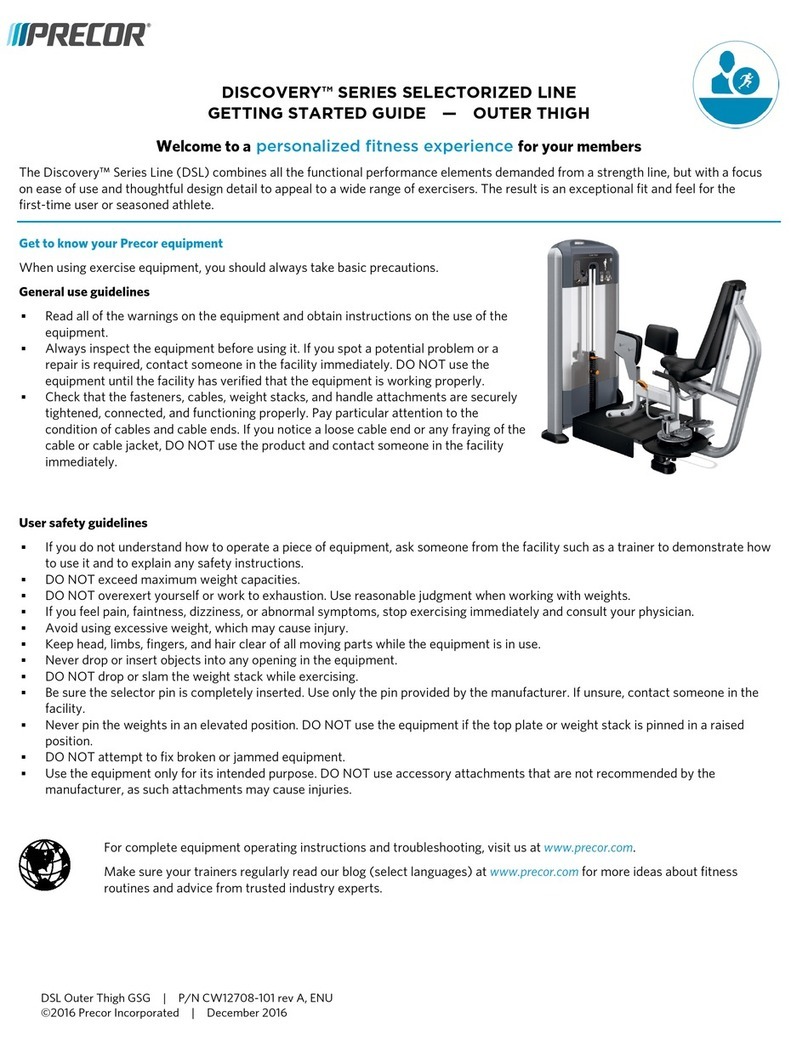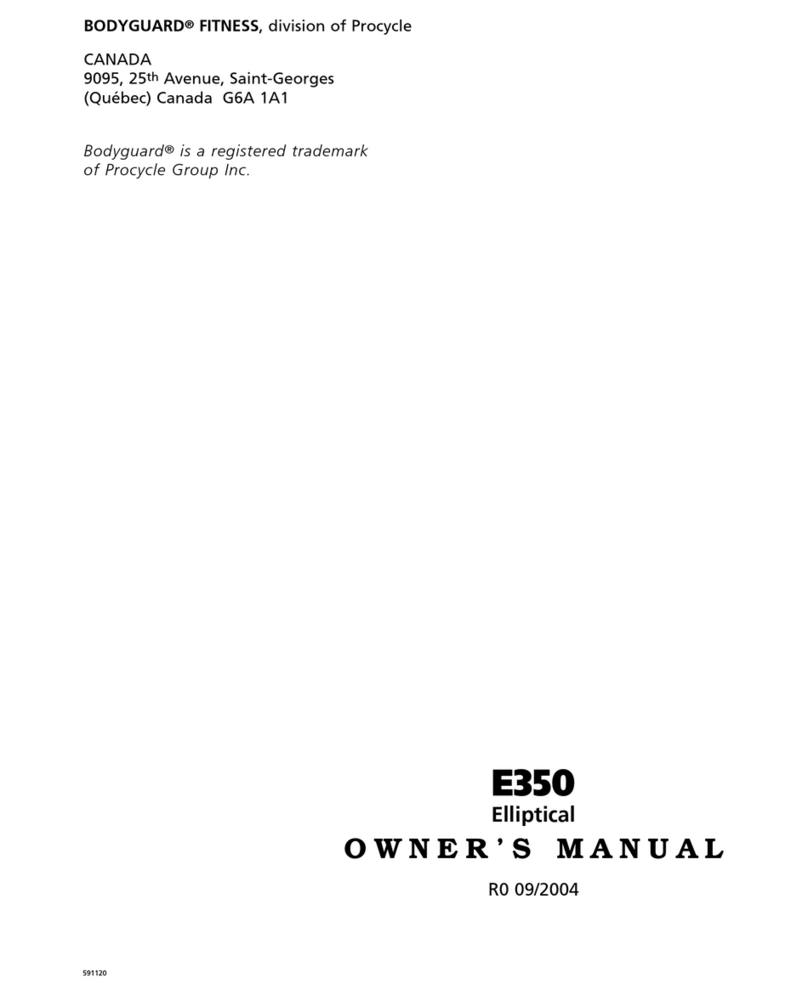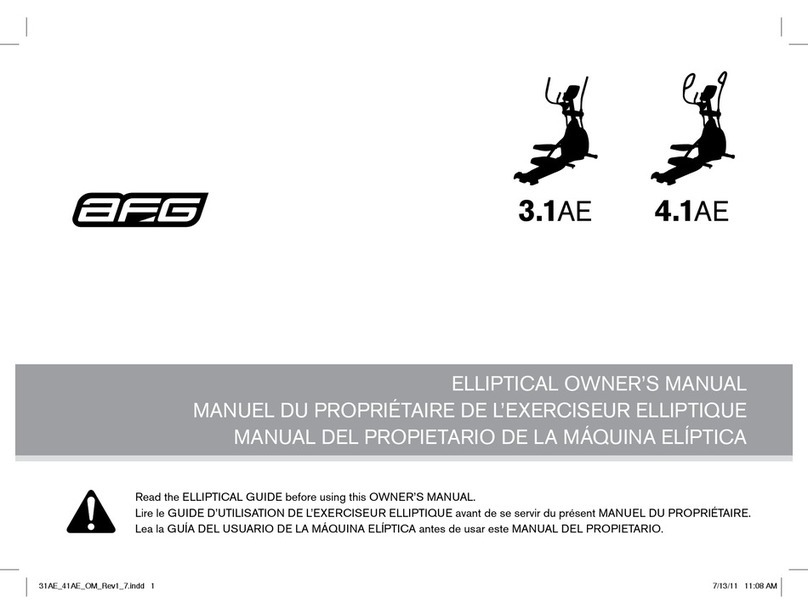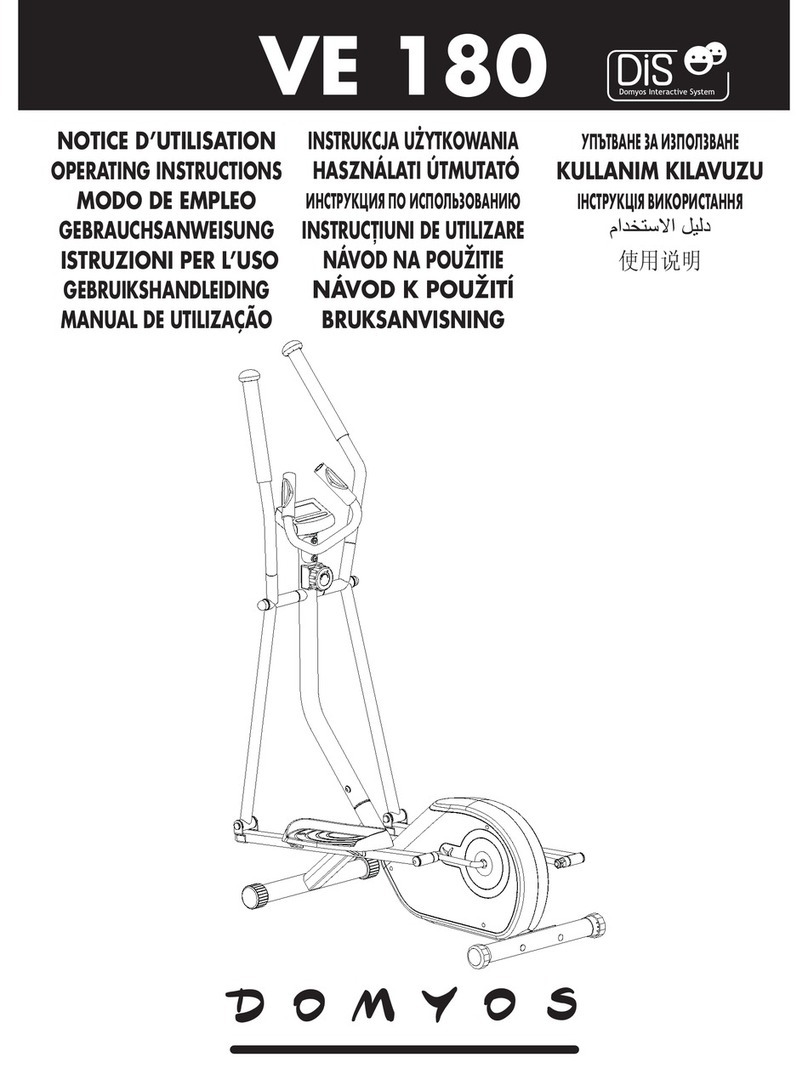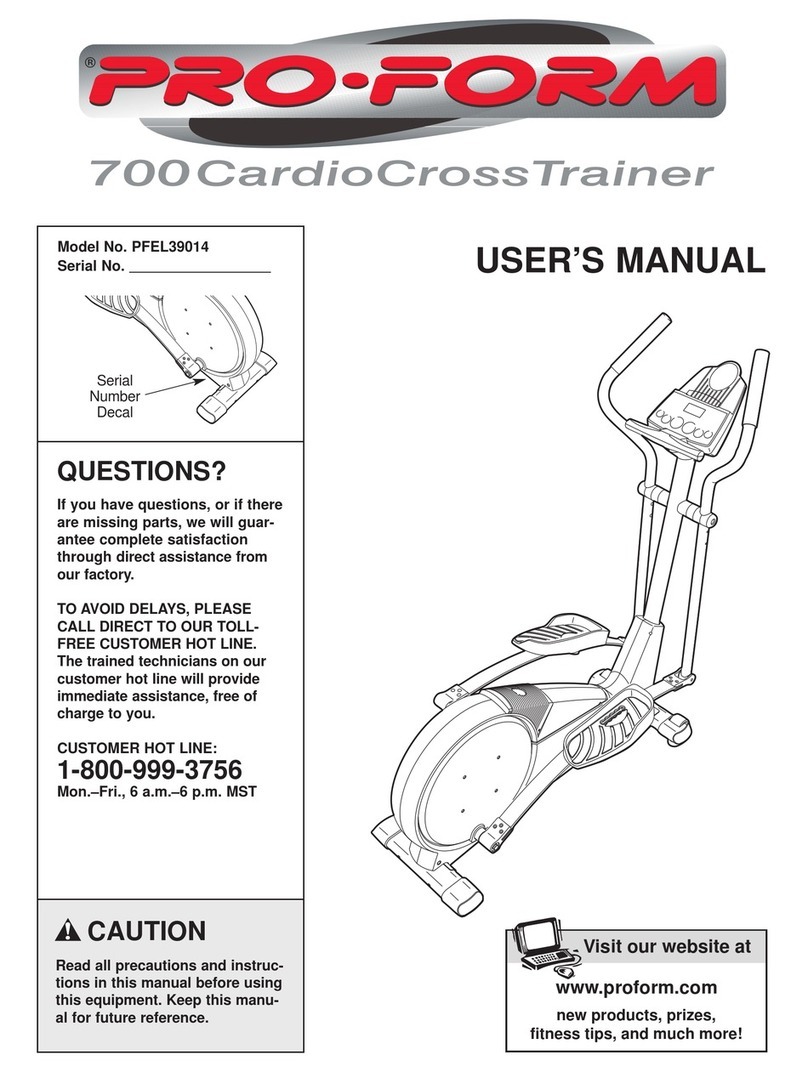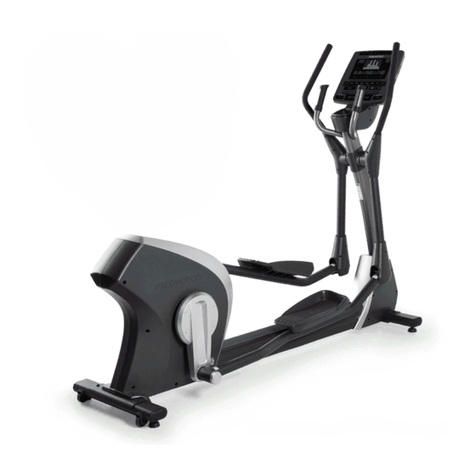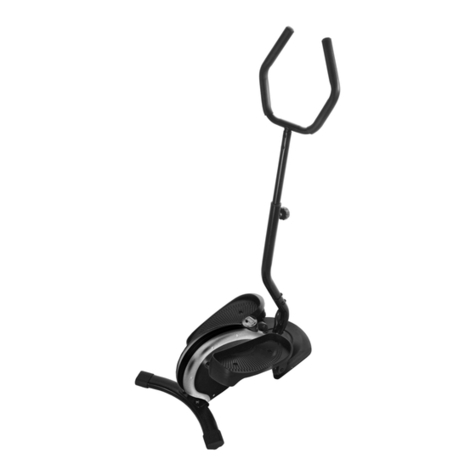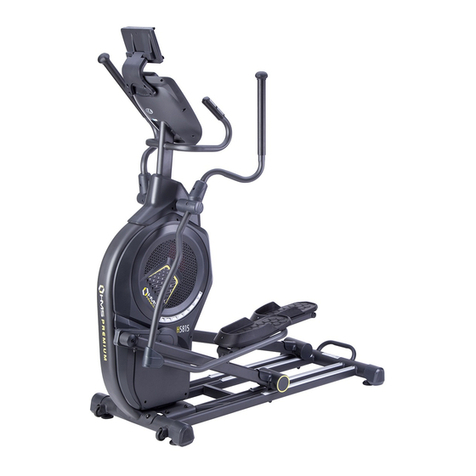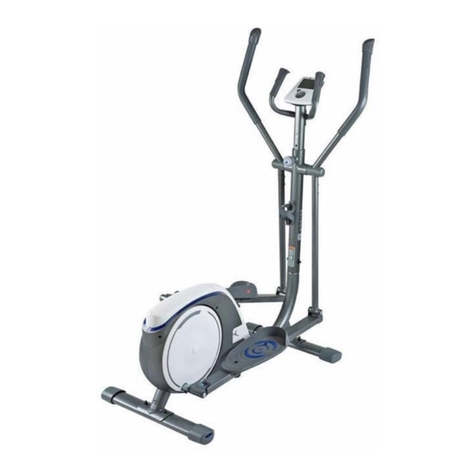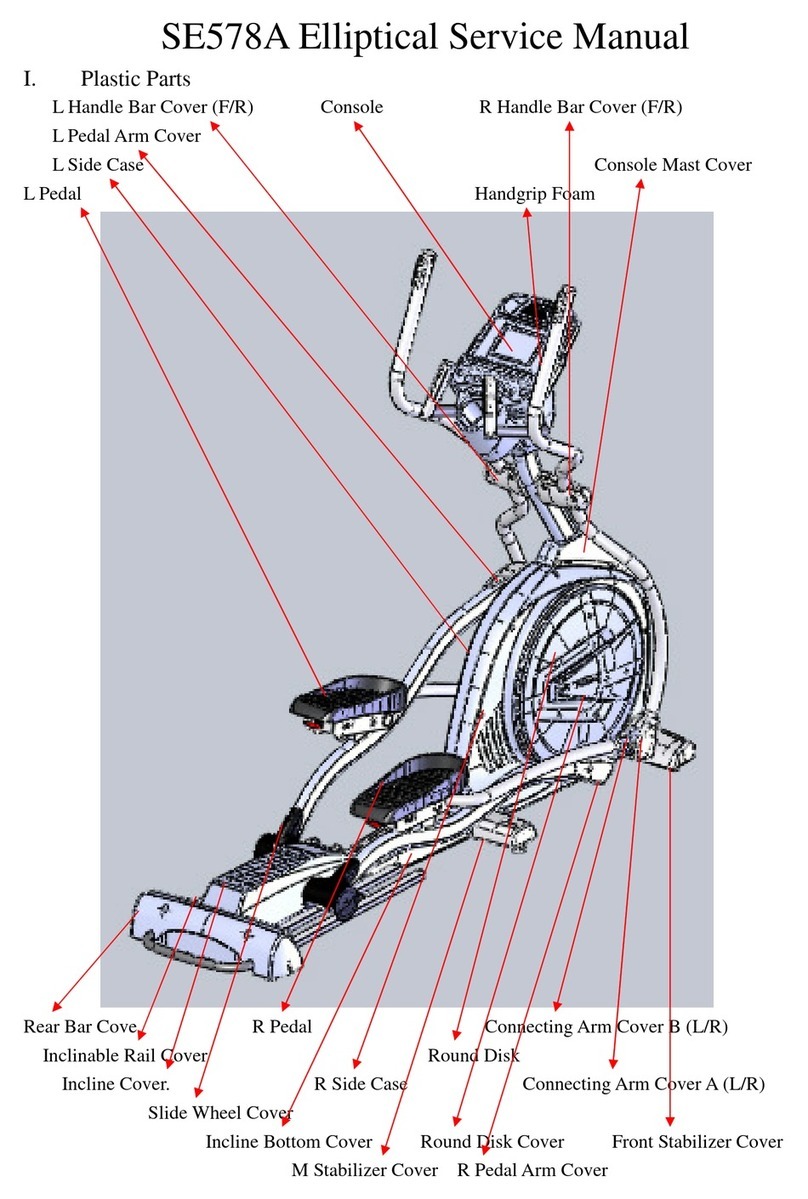PSX Elliptical User manual

Elliptical
Owner's
Manual

Intensive quality control
standards guarantee
excellence in every
phase of production,
resulting in the finest
products available in
the marketplace.
True treadmills are
consistently rated #1
for their smooth, quiet and
comfortable performance.
True is rapidly becoming the
choice for workouts among
beginners, rehab patients
and top athletes world-wide.
Today True offers a full line
of treadmills, upright and
recumbent bikes, elliptical
trainers, and flexibilty
equipment. True is proud to
“Deliver The Best!”
In 1981, Frank Trulaske
launched True Fitness
Technology, Inc. and
began manufacturing
hand-crafted treadmills.
His team’s obsession with
quality has
propelled True to the top
of the industry
and has created
one of America’s oldest,
largest and most
respected
fitness equipment
manufacturers.
Over the years, True has
designed, developed,
patented and fabricated
many new and cutting-
edge innovations for
their products: including advanced
features, manufacturing components
and technological breakthroughs.
Thank You For Selecting True
“Our original
goal was to
build the world’s
best fitness
equipment, and
today we believe
we’re doing it!”
-Frank Trulaske

When using this exercise machine, basic precautions should
always be followed, which includes the following:
Read and understand all instructions and warnings prior to use.
Obtain a medical exam before beginning any exercise program.
If at any time during exercise you feel faint, dizzy, or experience
pain, stop and consult your physician.
Obtain proper instruction prior to use.
Inspect the PSX Elliptical for incorrect, worn, or loose
components and do not use until corrected, replaced, or tightened
prior to use.
Do not wear loose or dangling clothing while using the elliptical.
Care should be used when mounting or dismounting the elliptical.
PSX Elliptical Owner’s Guide 3
Review for Your Safety

PSX Elliptical Owner’s Guide
Review for Your Safety
IMPORTANT SAFETY INSTRUCTIONS
4
Do not exceed maximum user weight of 300 lbs.
Keep all surfaces clean and dry.
Keep children and animals away.
All exercise equipment is potentially hazardous. If attention is
not paid to the conditions of equipment usage, death or serious
injury could occur.

PSX Elliptical Owner’s Guide 5
Table of Contents
4 - Heart Rate
Control
Foolproof heart rate
feedback workouts.
page 21
5 - Designing an
Exercise Program
Advice on using
your elliptical in a
rewarding exercise
program.
page 27
1 - Riding Your
Elliptical
Basic operation of
everything except the
console.
page 7
3 - Manual and
Pre-Set Programs
Details on basic
exercise modes.
page 17
2 - The Display
Describes each key
and data display
feature.
page 13
Quick Start
It’s easy to use your
new elliptical.
page 3
7 - Elliptical
Specifications
Operational and
physical attributes
of your elliptical.
page 37
6 - Care and
Maintenance
Keeping your
elliptical in the best
shape.
page 35

Quick Start Guide
PSX Elliptical Owner’s Guide
6
The best way to learn to use the PSX Elliptical is to keep
pressing keys to see what happens — explore it at your own
pace.
• Begin pedaling.
• The display will wake up and prompt for your weight,
workout selection, and workout time.
• Enter your workout parameters and press , or
immediately press for a quick start into a manual
workout.
At any time during your workout, change workouts by
pressing a program key.
The elliptical will retain your workout data for about 15
seconds after you stop pedaling.
Press the Display Shift key to change the workout
data display.
Just Get On
And Ride!
Starting Up
Change
Workouts
At Any Time
Pausing
Your
Workout
Change
the Display

chapter one
Riding Your Elliptical
Chapter 1: Riding Your Elliptical
Chapter 2: The Display
Chapter 3: Manual and Pre-Set Programs
Chapter 4: Heart Rate Control
Chapter 5: Designing an Exercise Program
Chapter 6: Care and Maintenance
Chapter 7: Elliptical Specifications 7

Using the Keyboard
Setting
Your Weight
PS 75 Treadmill Owner’s Guide
8PSX Elliptical Owner’s Guide
Getting Comfortable
8
Foot
Position
Using the
Exercise
Arms
Set your weight before every workout.
This allows the PSX Elliptical to control
your workout more effectively.
The body weight setting does not affect
the calorie expenditure calculation.
Unlike treadmills or other weight-
bearing exercises, calories burned
during elliptical riding does not change
with different body weights.
Place your feet anywhere on the foot pads. Most riders prefer
their feet to be as close together as possible, but choose your own
position for maximum comfort.
Grasp the exercise arms in a position so that you are well-balanced
and your arm motion is comfortable. Grip the handles with a
relaxed, not tight, grip.
You can use the exercise arms for mainly balance, or you can use
them for significant upper-body exercise. Any power you apply to
them will be accurately recorded by the elliptical console.
Variations in human
exercise efficiency
are another potential
source of error, with
differences of plus or
minus 10% common
in the population.

Manual Operation
PS 75 Treadmill Owner’s Guide 9
Breathing
PSX Elliptical Owner’s Guide 9
Monitoring Heart Rate
Monitoring
Your Heart
Rate
Breathe in a regular and relaxed manner. Many exercisers do
not breathe enough, which reduces their exercise capacity and
comfort. You might want to try breathing deeper and more
frequently to see if it helps your exercise regimen.
The PSX Elliptical has two ways of monitoring your heart rate:
...By using a chest strap that transmits your heart rate to the bike
via radio...
...or by using the metal contact heart rate pads on the handlebars.
Although your elliptical functions fine without using the heart
rate monitoring feature, this kind of monitoring gives you valuable
feedback on your effort level. Chest strap monitoring also allows
you to use Heart Rate Control, which is the most advanced
exercise control system available.

Chest Strap
Heart Rate
Monitoring
When you wear a Polar® or compatible transmitter strap, the
elliptical will display your heart rate as a digital beats-per-minute
(bpm) readout.
The transmitter strap should be worn directly against your skin,
about one inch below the pectoral muscles/breast line (see picture
below). Women should be careful to place the transmitter below
their bra line.
Some moisture is necessary
between the strap and your skin.
Sweat from your exercise works
best, but ordinary tap water may
be used prior to your workout if
desired.
Examples of Heart Rates
Found in Daily Life
An average 30-year-old might
have a resting heart rate, when
sitting totally still for several
minutes, of 65. During hard
exercise that can be sustained
for 10 to 15 minutes it might
be around 140 continuously.
A maximum heart rate that
requires maximal exercise for
several minutes to attain is 185.
A 30-year-old in good shape
might have a resting heart rate
near 55, and might exercise for
20 minutes at a heart rate of
160.
A world-class distance runner
or professional cyclist might
have a resting heart rate near
45.
Chest Strap Heart Rate Monitoring
PSX Elliptical Owner’s Guide
10

Using CHR
Contact
Heart Rate
(CHR)
The contact heart rate system lets you monitor your heart rate
without wearing a strap.
Gently grasp the contact heart rate pads. When the system detects
your hands, a red heart will appear in the Heart Rate field of the
data display and will flash in time with your heart beat. During
this time, the system is analyzing and locking in your heart rate.
Within about 15 seconds, your digital heart rate in beats per
minute (bpm) should be displayed.
A Note on
CHR Accuracy
CHR monitoring may be a bit less
accurate than a chest strap, since
the heart rate signals are much
stronger at the chest.
About 5% of the population
cannot be picked up by any CHR
system. is is because their
heart is positioned in a more up-
and-down manner in their chest,
as opposed to leaning over to one
side.
PSX Elliptical Owner’s Guide 11

PSX Elliptical Owner’s Guide
Contact Heart Rate
12
For Best
Results
1. Exercise with smooth body motions.
2. Breathe smoothly and regularly, and avoid talking.
(Talking will cause unrepresentative heart rate spikes of 5
to 10 bpm.)
3. Grip the pads lightly, not tightly.
4. Make sure your hands are clean, free of both dirt and
hand lotions.
When using a Heart Rate Control (HRC) workout, it is best to
use chest strap monitoring. These workouts work best with the
extra accuracy gained from a chest-contact heart rate monitoring
system.

chapter two
The Display
Chapter 1: Riding Your Elliptical
Chapter 2: The Display
Chapter 3: Manual and Pre-Set Programs
Chapter 4: Heart Rate Control
Chapter 5: Designing an Exercise Program
Chapter 6: Care and Maintenance
Chapter 7: Elliptical Specifications 13

Using the Keyboard
Your Display
PS 75 Treadmill Owner’s Guide
14 PSX Elliptical Owner’s Guide
Your Display
14
The elliptical display has two jobs: to let you control the elliptical
operation, and to give you feedback about your workout. The
controls are simple and designed to be foolproof; it’s hard to
press a “wrong” key. You can monitor several different kinds
of physiological data, and your workout progress is tracked
graphically with the center matrix display.

The Upper Panel
METs: Your
METs rate.*
*Pressing
the “Display Shift” key switches
the readout from the top values to
the bottom values and will light up
the LEDs of the values now being
displayed. If you press and hold the
“Display Shift” key for one second, the
display will enter “Scan Mode” and
switch between the two sets of values.
Progress Display:
Shows your progress
and workload
profile through your
workout.
The Display
Time: The amount of time
remaining in your workout. If
you press , this becomes
elapsed time: how long you’ve
been working out
so far.*
Distance: An estimate
of your walking or
running distance for a
comparable amount of
calories expended.*
Heart Rate:
In beats per
minute (bpm).*
Calories: An
estimate of your
calories burned. This
doesn’t include your
basal metabolic
rate, which is about
72 calories per hour
for a 150-pound
person.*
Display Shift: Changes data readouts from
one set of four to the other set. Press and hold
for two seconds to automatically have the
two sets alternate back and forth every five
seconds.*
Work Level:
The selected
workout level.
RPM: Your pedal
cadence. *
Watts: The amount of
mechanical power the elliptical is
receiving from your exercise. This
is not the same as the amount of
power your body is using, since
the average person is only about
20% efficient at generating
mechanical power. *
PSX Elliptical Owner’s Guide 15

PSX Elliptical Owner’s Guide
The Lower Panel
16
Start:
Starts a
workout
Random: Generates
a different program
profile each time
The Display
Cruise Control: Selects
Constant Heart Rate
Control. If already in a
workout, selects Cruise
Control HRC.
Pre-set Programs:
Selects desired
program profile.
Workload: Adjusts
workload up and
down. Keys repeat if
held down.
Enter: Accepts the
current data entry.
Numeric: Used
for data entry in
workout setup.
During a workout,
used to change
workload by
entering a numeric
value and pressing
.
Clear: Zeros-
out current
data entry.

chapter three
Manual and Pre-Set
Programs
Chapter 1: Riding Your Elliptical
Chapter 2: The Display
Chapter 3: Manual and Pre-Set Programs
Chapter 4: Heart Rate Control
Chapter 5: Designing an Exercise Program
Chapter 6: Care and Maintenance
Chapter 7: Elliptical Specifications 17

Using the Keyboard
Manual
Mode
PS 75 Treadmill Owner’s Guide
18 PSX Elliptical Owner’s Guide
How These Modes Work
18
Pre-Set
Programs
Use the keys to change workload. Manual mode changes
workload in roughly 10-watt increments.
Three different preset programs are available:
• C-V Workout, with the workload gradually rising until
you reach the middle of your workout time, then
gradually decreasing to the end.
• Weight Loss, with a warmup stage increasing to a
steady-state workload for the majority of the workout,
then a cool-down at the end.
• Hill Interval, with four work intervals separated by four
rest intervals.
The Random program creates a different program profile each
time you press the key.
Sixteen different levels are available to change the difficulty
of a program. The workload intensities expand and contract
depending on the level.

Program Profiles
PS 75 Treadmill Owner’s Guide 19
PSX Elliptical Owner’s Guide 19
Program
Profiles
C-V Workout
Weight Loss
Hill Interval

chapter four
Heart Rate Control
Chapter 1: Riding Your Elliptical
Chapter 2: The Display
Chapter 3: Manual and Pre-Set Programs
Chapter 4: Heart Rate Control
Chapter 5: Designing an Exercise Program
Chapter 6: Care and Maintenance
Chapter 7: Elliptical Specifications 21
Table of contents

